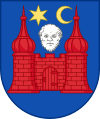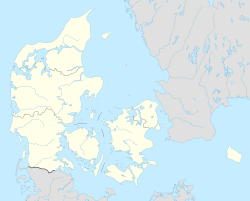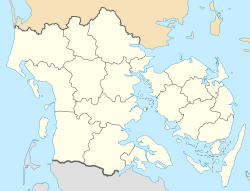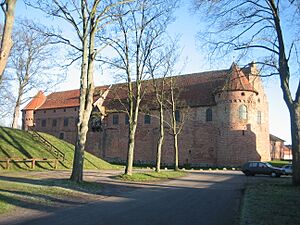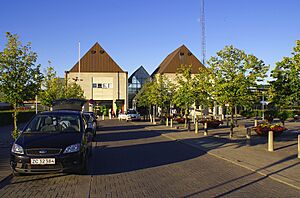Nyborg facts for kids
Quick facts for kids
Nyborg
|
||
|---|---|---|
|
City
|
||
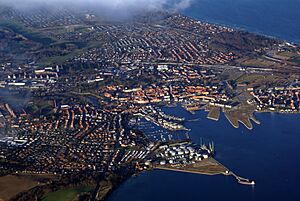
Aerial view of Nyborg
|
||
|
||
| Country | Denmark | |
| Region | Southern Denmark | |
| Municipality | Nyborg | |
| Founded | Early 1200s | |
| Area | ||
| • Urban | 11.3 km2 (4.4 sq mi) | |
| Population
(2024)
|
||
| • Urban | 17,902 | |
| • Urban density | 1,584/km2 (4,103/sq mi) | |
| • Gender | 8,582 males and 9,320 females | |
| Demonym(s) | Nyborgenser | |
| Postal code |
5800
|
|
| Website | Nyborg.dk | |
Nyborg is a city in central Denmark. It is located on the island of Funen and is the easternmost city there. In 2024, about 17,900 people lived in Nyborg.
The city is part of Nyborg Municipality. It is about 34 km (21 mi) east of Odense. Nyborg also connects to Korsør by the impressive Great Belt Bridge.
Nyborg was founded in the early 1200s. It grew up around Nyborg Castle, which is still a very important part of the city's history and culture.
Contents
What's in a Name?
The name Nyborg was first used in 1193. It was called 'Nyburg', which means 'new castle' in Danish. This name clearly shows how important the castle was to the city's beginning.
Nyborg's Story
Before Nyborg was built, there was an older fort called Gammelborg. It was set up in the 500s and used during the Viking Age. Nyborg later took its place.
Nyborg Castle was first mentioned in 1193. The city itself was mentioned a bit later, in 1202. For many years, until 1413, Danish kings used Nyborg Castle for important meetings. These meetings were called the Danehof.
Royal Privileges and Growth
In 1282, King Eric V wrote the first Constitution of Denmark at Nyborg Castle. Because the castle was so important, Nyborg received many special rights from the king.
One of the first rights was given by King Valdemar II. He made Nyborg a market town (Købstad). This meant merchants from nearby areas had to come to Nyborg to sell their goods. This helped the city's economy grow.
In 1446, even more special rights were added. Nyborg was allowed to hold a yearly market. Also, skilled workers from nearby areas were told to move to market towns like Nyborg. This helped the city's population and economy grow even more.
Nyborg as Capital
In 1525, King Frederick I said Nyborg would be his home. Until the 1560s, Nyborg even acted as the capital of Denmark! During this time, King Christian III made Nyborg Castle and the city bigger. He rebuilt parts of the castle and added a tournament ground.
Wars and Changes
Nyborg was captured by Swedish soldiers during the Dano-Swedish War (1658–1660). This happened after the Battle of Nyborg. The Swedish troops took many valuable things and damaged Nyborg Castle.
Later, an allied army of Danes, Germans, Poles, and Dutch soldiers took the city back. After the war, the king no longer wanted to live in the castle. It was given to the military and became an army base.
The 1700s were a tough time for Nyborg. There were wars, fires, and animal diseases. But things got better in the 1800s. Nyborg became a key link across the Great Belt strait. Steamboat ferries started sailing between Nyborg and Korsør in 1828. Trade and the economy began to grow again.
Modern Nyborg
During the Second World War, Nyborg still had its army base. Danish soldiers stayed in places like Nyborg Vandrehjem and Hotel Nyborg Strand. In 1943, there were battles between Danish and German soldiers at these locations.
In 1977, the old "market town" system ended. Nyborg Municipality was created, with Nyborg as its main city. In 2007, Nyborg, Ørbæk, and Ullerslev merged to form the current Nyborg Municipality.
Mayors of Nyborg
Since 1919, the mayor of Nyborg has been chosen by the people. Before that, the king picked the mayor. Today, Kenneth Muhs is the current mayor, representing the Venstre party.
Nyborg Castle
Nyborg Castle is located close to the city center. It is surrounded by old forts, a 'castle lake', and a moat. The castle was first mentioned in 1193.
In the early 1200s, a two-story building was added to the castle. Kings likely held their important meetings on the top floor. Over the next two centuries, the castle was improved with new floors and buildings.
After the Dano-Swedish War, the castle became less important. It was used as an armory (a place to store weapons). The army base closed in 1913. Since then, Nyborg Castle has been a museum. A big project to make the museum even better started in 2017.
Castle Fortifications
The old forts, walls, and moats around Nyborg Castle still stretch through the city center. The moats look much like they did in the Middle Ages. They even use the same water systems!
Three of the original strongholds, called bulwarks, still exist. Two are near the castle: the Queen's Bulwark and the Crown Prince's Bulwark. These are surrounded by the original walls, which are now park areas. On the Queen's Bulwark, there is a water tower from 1899.
The third bulwark is called Prince Carl's Bulwark. It is also a park area.
Nyborg Church
Nyborg Church, also known as Church of Our Lady (Vor Frue Kirke), is in the heart of Nyborg. It was built between 1375 and 1428. The church has been updated several times, including in the 1970s and 2005.
The church has two organs. The crucifix is the only item left from when the church first opened in 1428. It shows scenes from the Bible. A modern altar crucifix was added in 2011.
One large chandelier was given to the church in 1640 by a mayor's widow. Another was given by Mayor Mads Lerke in 1589. The church also has two baptismal fonts. One is from the Renaissance period (1585), and the other is a much older Romanesque style granite font from the 1100s.
Inside, you can see a gate from 1649. The pulpit, where sermons are given, was made in 1653. It has wooden figures of John the Apostle and Jeremiah. A special candle globe, made by a local artist, was added in 2008.
The church's old clock, nicknamed "the Syrian tank," was replaced in 1972. The original mechanical clock was made for Viborg Cathedral but Nyborg Church bought it instead. In 2002, it was given to a museum in Copenhagen.
Getting Around
Nyborg has a railway station that connects to major cities. You can catch trains between Copenhagen and Jutland here. The station is on a line that links Denmark's capital, Copenhagen, to the Jutland peninsula. It does this by crossing the islands of Zealand and Funen.
Famous People from Nyborg
Many interesting people have come from Nyborg.
Royalty and Nobles
- Christian II of Denmark (1481–1559), a king of Denmark, Norway, and Sweden.
- Elizabeth of Denmark (1502–1535), a princess who became an electress in Germany.
- Christina of Denmark (1521–1590), a princess and a ruler of Lorraine.
Artists and Performers
- Carl Aarsleff (1852–1918), a sculptor who made statues.
- Frederik Jensen (1863–1934), an actor.
- Holger Juul Hansen (1924–2013), another actor.
- Erik Balling (1924–2005), a famous film director.
- Elsebeth Egholm (born 1960), an author who writes books.
- Signe Svendsen (born 1974), a singer.
- Søren Huss (born 1975), also a singer.
Sports Stars
- Ragnhild Hveger (1920–2011), a famous swimmer.
- Leif Printzlau (born 1948), a football player.
- Søren Skov (born 1954), another football player.
- Lars Lunde (born 1964), a former football player.
- Dorte Jensen (born 1972), a sailor.
- Kathrine Heindahl (born 1992), a handball player.
- Søren Toft Hansen (born 1992), a badminton player.
- Frederik Søgaard (born 1997), also a badminton player.
Images for kids
See also
 In Spanish: Nyborg para niños
In Spanish: Nyborg para niños


